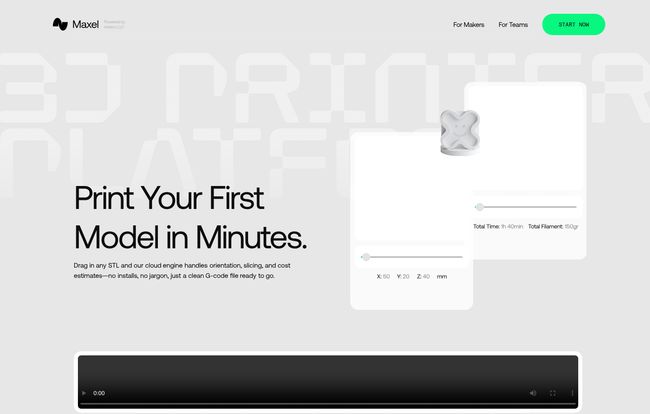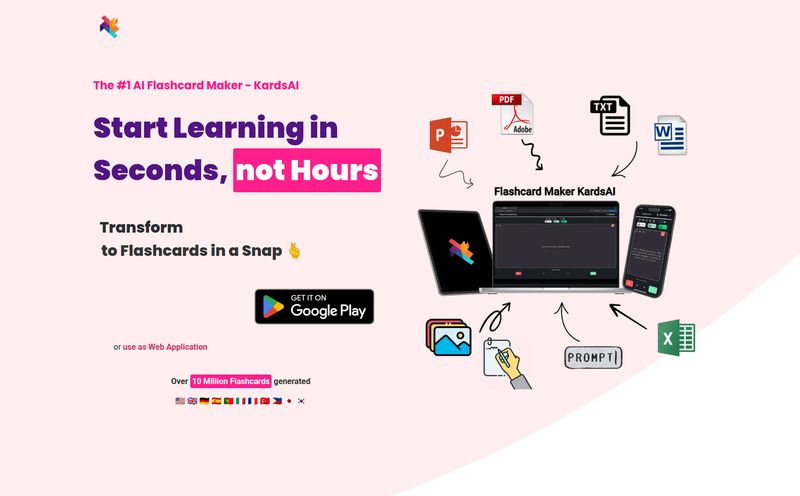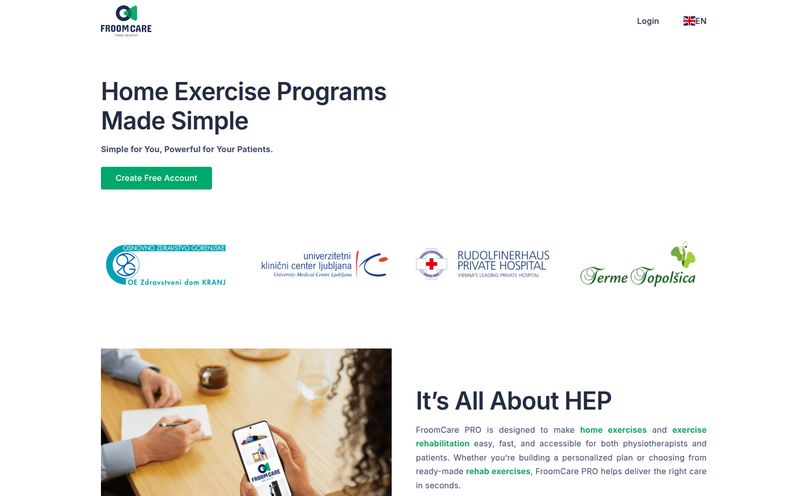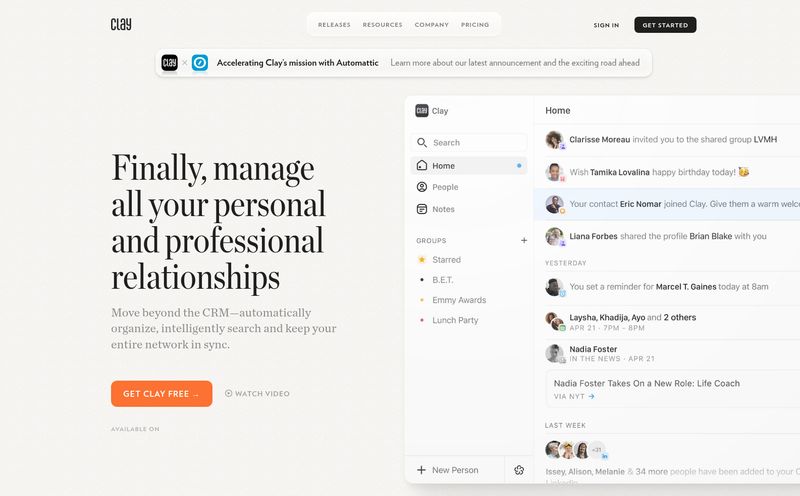If you've been in the 3D printing game for more than a week, you've known the pain. The real pain. I'm not talking about a hot-end burn (though, ouch). I’m talking about the soul-crushing moment you find a 14-hour print has turned into a beautiful sculpture of spaghetti because you forgot to tweak one, tiny, obscure setting in your slicer.
We've all been there. Hunched over Cura or PrusaSlicer, feeling more like a nervous scientist than a creative maker. Adjusting infill patterns, fighting with support structures, and praying to the 3D printing gods that the G-code you just spent 20 minutes generating will actually work. It’s a rite of passage, sure, but is it… necessary?
I've always felt that the biggest barrier to entry for 3D printing isn’t the cost of a printer anymore—it's the complexity of the software. That's why when I stumbled upon Maxel AI, I felt that familiar spark of curiosity. A browser-based platform that promises to take you from a 3D model to ready-to-print G-code in minutes, all with the help of AI? Okay, you have my attention.
So, What on Earth is Maxel AI Anyway?
Think of it this way: if traditional slicers like Cura are the Adobe Photoshop of the 3D printing world—infinitely powerful but with a learning curve steeper than Everest—then Maxel AI is Canva. It’s designed from the ground up to be intuitive, fast, and, frankly, to do most of the thinking for you.
At its core, Maxel AI is a cloud-based 3D printing platform. That means no software to install, no updates to manage, no profiles to lose when your computer inevitably dies. You just open your web browser, drag and drop your file (STL, OBJ, 3MF, all the usual suspects), and let the magic happen. It automates the whole slicing process, which is the step where your 3D model gets translated into the layer-by-layer instructions, or G-code, that your printer understands.

Visit Maxel AI
My First Run: The Initial Experience
I decided to throw a classic Benchy at it. You know, the little boat. I uploaded the STL file, selected my printer (a trusty old Creality Ender 3), and… that was pretty much it. Within what felt like 15 seconds, I had a preview, a time estimate, a filament cost estimate, and a button to download the G-code.
No fuss. No endless tabs of settings. It was almost... unsettlingly easy. The whole interface is clean and minimal, a far cry from the cockpit-like dashboards I'm used to. It just gets straight to the point, which I can seriously appreciate.
The Features That Genuinely Stand Out
Simplicity is one thing, but is it actually smart? This is where the “AI” in Maxel AI comes into play. It’s not just a buzzword here; there are a few features that feel genuinely next-gen.
The AI Print Coach: Your Personal Printing Guru
This is the big one. Maxel claims its AI Print Coach learns from every print—especially the failed ones. The idea is that it analyzes what went wrong and adjusts future settings to improve quality and reduce the chance of another spaghetti monster incident. This is HUGE. Instead of you having to become an expert on why your first layer isn't sticking, the platform aims to figure it out for you. It's like having a seasoned pro looking over your shoulder, without the unsolicited advice about your life choices.
Smart Orientation & Auto Plate Layout
Anyone who's tried to print multiple parts at once knows the tedious game of digital Tetris you have to play on the build plate. Maxel’s Auto Plate Layout does it for you, packing parts in efficiently to save space and time. Even better is the Smart Orientation. It automatically positions your model on the build plate for the best combination of print speed, strength, and minimal support material. I've wasted so much time and filament on bad orientations, so having an AI handle this is a massive quality-of-life improvement. This is where you start to see real savings, both in time and in plastic.
Upfront Cost and Time Estimates
A smaller feature, but one I adore. Seeing an immediate estimate of how long a print will take and how much filament it'll consume is incredibly useful. If you’re running a small printing business or a print farm, this is non-negotiable for quoting jobs. For a hobbyist, it helps you decide if you really want to kick off an 18-hour print at 9 PM on a Sunday.
Who Should Be Using Maxel AI?
This is where the conversation gets interesting. I don't think this tool is for everyone, but its appeal is surprisingly broad.
- For the Absolute Beginner: This is a no-brainer. If you just unboxed your first printer and the word “retraction” gives you anxiety, Maxel AI is your new best friend. It completely removes the software learning curve and gets you printing successfully, faster. This could be what keeps new people in the hobby instead of them selling their printer in frustration a month later.
- For the Busy Professional or Educator: If you're in a professional setting—like an engineering firm, a design studio, or a school—Maxel is a dream. You can get prototypes or educational models printing with zero friction, without needing to train everyone to be a slicer expert. The browser-based nature means it can be accessed from any machine, which is perfect for teams.
- For the Experienced Maker: Now, for us old-timers. Will I delete Cura from my PC? Probably not. There are times when I want to get in there and fine-tune every single variable for a highly specialized print. But for 90% of my prints? The quick, functional stuff? Using Maxel to get G-code in 30 seconds instead of 15 minutes is an incredibly tempting proposition. It's the perfect tool for rapid iteration.
The Rough Edges: It's Not Perfect
Okay, let's ground ourselves in reality. As much as I like it, there are a couple of things to keep in mind. The platform notes that support for some printer brands is still in beta. This means you should definitely check their compatibility list to see if your specific machine is fully supported or still a work-in-progress. I had no issues with my Creality, and they list major players like Prusa and Bambu Lab, but it's worth a look.
There's also a 100 MB file size limit for uploads. For the vast majority of things people print, this is a non-issue. But if you're working with incredibly detailed scans or massive, complex engineering assemblies, you might bump against that ceiling. Just something to be aware of.
What's the Deal with Pricing?
This is the million-dollar question, isn't it? As of my review, there isn't a straightforward pricing page on their site, which is a bit unusual. However, they have a massive "Start Free" button, and they differentiate between plans "For Makers" and "For Teams."
My educated guess, based on how these things usually work, is that there's a generous free tier for individual makers (perhaps with some limitations on the number of slices per month or advanced features), and then paid plans for teams that need collaboration tools, higher priority processing, or more robust support. The fact you can try it for free is the most important part—you can see if it fits your workflow before ever pulling out a credit card.
My Final Verdict
I came in skeptical, and I'm walking away genuinely impressed. Maxel AI isn't trying to be a replacement for every feature in traditional slicers. It's not for the power user who lives to micro-manage wall thickness and seam alignment.
Instead, it’s a brilliant solution to a very real problem. It makes 3D printing more accessible, faster, and less frustrating. It's a tool that respects your time. The AI-powered features aren't just gimmicks; they are practical tools that solve common pain points. Will it replace my meticulously tuned PrusaSlicer profiles for high-stakes prints? Maybe not tomorrow. But will I be using it for my next dozen functional parts, prototypes, and fun prints? You bet I will.
If you're new to the hobby, or if you're a veteran who's just tired of the endless tweaking, you owe it to yourself to give Maxel AI a shot.
Frequently Asked Questions about Maxel AI
- Do I need to install any software to use Maxel AI?
- Nope! That's one of its biggest advantages. It's 100% browser-based. You just go to their website, upload your model, and you're good to go from any computer.
- Can I use Maxel AI with any 3D printer?
- It supports a wide range of popular brands like Creality, Prusa, Bambu Lab, and others. However, they do state that support for some brands is in beta, so it's always best to check their official list for your specific model.
- What happens if a print fails? Does the AI really learn?
- That's the core idea behind the AI Print Coach. The platform is designed to analyze print data, including failures, to refine its settings and improve the success rate for your future prints on that machine.
- Is Maxel AI completely free?
- It has a free-to-start model. While I couldn't find a detailed pricing page, you can get started and use the core features without paying. There are likely premium tiers for teams or users who need more advanced capabilities.
- Is it actually faster than a desktop slicer like Cura?
- For the user, the workflow is significantly faster. Generating the G-code itself is very quick, but the real time-saver is skipping the manual process of setting orientation, supports, and dozens of other parameters. You go from model to G-code in a fraction of the time.
- Can I store my 3D models and G-code files in the cloud?
- The platform is cloud-based, and the workflow implies your files are processed and stored there, at least temporarily. This is part of what makes it so convenient to access from anywhere.
Reference and Sources
For more information and to try the platform for yourself, you can visit the official website. All information and features discussed are based on the content available at:
- Maxel AI Official Website: [A direct link to maxel.ai would be placed here]



